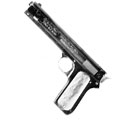- 01: Introduction
- 02: History
- 03: Propellants, Firearms, and Ammunition Development
- 04: Modern Firearms Manufacture
- 05: Small Arms Ammunition
- 06: Evidence Handling Procedures
- 07: Equipment and Instrumentation
- 08: Examination of Firearms
- 09: Cartridge and Shotshell Examination
- 10: Characterization and Evaluation of Fired Projectiles
- 11: Bullet Comparison and Identification
- 12: Gunshot Residue and Distance Determination
- 13: Toolmark Identification
- 14: Communicating Results
- Resources


1908-1915
Home > History > 1908-1915
1908

The Wisconsin State Court allowed expert testimony and experimentation regarding distance determination using observations of the presence and/or absence of gunpowder at various distances.
1912

Side by side comparison
of
lands and grooves
on two bullets
French Professor V. Balthazard uses a series of photographic comparisons to link fired bullets to the firearm from which they were fired. Rifled areas of each land and groove were photographed and enlarged, allowing the comparison of individual markings. Balthazard applied these photographic comparison techniques to the cartridge cases using firing pin, breech face, ejector, and extractor marks.
1915
Illiterate tenant farmer Charles Stielow was convicted of killing his employer and the employer’s housekeeper. Stielow’s conviction was based in part on the testimony of an alleged firearm examiner who stated that a revolver found in Stielow’s house had fired the fatal bullets.
Charles E. Waite, a special investigator for the New York Attorney General’s Office, was appointed by the governor of New York to reinvestigate the Stielow case. Waite and Dr. Max Poser, a microscopy expert with Bausch & Lomb, microscopically examined and compared the fatal bullets with bullets test fired from Stielow’s revolver. They determined that Stielow’s revolver could not have been used to fire the fatal bullets. This conclusion, together with other aspects of the investigation, led the governor to pardon Stielow and release him from prison.
1916

Colt 1900 model
Charles E. Waite began gathering data on U.S. and foreign small arms including manufacturer, caliber, and rifling (number, twist, and size of rifling). He continued collecting and tabulating data through 1925.




